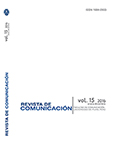
Editorial
Paraphrasing the book, El mundo es ancho y ajeno, by the Peruvian writer Ciro Alegría, we must say that the current world of communication or the age of information and communication is becoming wider, and that is more hyperconnected, but it is not always suitably.
It is a world that will continue transforming itself; those who are in this profession know, with P. Steiger (2016), that the only constant in the sector is the change. We have to assume the “culture of change” and analyze it, understand it, make use of it –experience, risk and innovate–, and manage it; taking into account that the quality content is the key in the media business, as Orihuela (2015) states.
The content is still the king and stands as one of the five keys of Communication Industry in the Global Entertainment Media Outlook 2016-2020 (PricewaterhouseCoopers, 2016). With that perspective and from the academy, we tried to gauge such constant change of communication in today's digital environment.
This issue contains ten articles: five of them are linked to the digital world and are related to the use of social networks, Twitter and Facebook, in political communication, changes that have occurred in journalistic practices of newsrooms, the immediate and risky communication in social networks, around a natural disaster such as the earthquake in Ecuador, the experiential marketing, also favored by the networks, and the new phase of globalization. The other four are related to essential aspects of communication, regardless of the channel in which they are finally transmitted. We refer to the poetic notion of "sense" in the service of “screenwriting” the historical study of the identity of the journalist, the right to privacy, and political communication contained in the press.
Political communication has always been a subject of study. The position of the media facing diversity of issues, especially government, constantly concerns about their influence in society. This has led Marcelo Borrelli and Maria Fernanda Ochoa, professors at the Universidad de Buenos Aires, to examine the newspapers Clarin, La Prensa and La Nación, before the enactment of the “Punto Final” Law in 1986.
This research, on political communication, is also made in new media, covered from digital tools as elements that mediate this communication, providing it with its own characteristics in the development, dissemination and consumption of messages sent, as well as the promoting action generated by the interaction of various actors.
From this perspective, Professor Alberto López Hermida of the Universidad de los Andes approaches to Hillary Clinton’s campaign on Twitter, analyzing the female stereotype in 140 characters, designed by the american candidate at the beginning of her presidential campaign. The use of microblogging as a resource to transmit its strengths as a woman. In the same line, from the social network of Facebook, the argentinian professor Ana Slimovich bring us closer to the digitization of politics and the return of the TV, from the case of argentinian candidates on Facebook.
Twitter is also used as a channel for citizen journalism. Diana Rivera Rogel and Claudia Rodriguez, professors at the Universidad Técnica de Loja, are studying what happened to the messages issued by the microblogging in Ecuador earthquake of April 16, 2016.
This diversity of use of social networks and other journalistic practices derived from new technologies in the media has generated changes in newsrooms and the work within them. Professor Francisca Green, in her article “Chileans online media: differences in some journalistic practices over traditional print media”, mainly observed the pattern, the editor’s job and their relationship with journalists and some reporting and writing techniques of journalists from these online media.
Studies of consumer behavior show that they value the consumer experience. Experiential marketing has proposed actions that generate an experience in which the consumer establishes an emotional, rational or sensory connection with the brands in the purchase process. Fran Arbaiza and Lourdes Rodriguez from the Universidad de Piura, aim to define the experiential formulas, among which is the shopping experience 2.0, that major retail stores offer in Piura.
The peruvian ambassador Librado Orozco Zapata, from his diplomatic experience, reflects on subnational actors in the new phase of the globalization process in which thanks to the information and communications technology the role and activity of various actors has largely boosted, in both outside and within the states.
Jorge Rodríguez, professor at the Universidad San Jorge, develops the "Features of the figure of the journalist in the early studies of journalism in Spain. Toward a professional identity (1891-1912)", which will allow us to compare the features maintained in the digital environment.
Carmen S. Brenes, from the Universidad de los Andes, proposes that the notion of “sense” as stated by Juan José García- Noblejas (1982) is capable of illuminating the “screenwriting” and film reception. It leads to the unity of the stories that eventually captivate audiences.
The right to privacy is a permanent topic in the communication field because of the vulnerability in its respect. The spanish professor Angela Moreno analyzes the reports recorded with hidden cameras as a special case of illegal interference in the right to privacy, from the jurisprudence of the Spanish Constitutional Court in 2012.
Since 2002, the scientific journal of the School of Communication of the Universidad de Piura has been published regularly, on an annual basis. In fifteen years of publication, the Journal of Communication has grown in academic contributors from several universities, specialized in multiple fields of communication. Currently all articles are open, in the online edition, using the Creative Commons license.
The Communication Journal will become a biannual publication in 2017. The two editions of each year will be published in print and online in March and September.
It is open to professors and researchers from all countries and it aims to promote reflection and discussion of specialists, in which solid and suitable initiatives for both academia and industry are generated. We invite you to enrich this academic forum.
The editor
